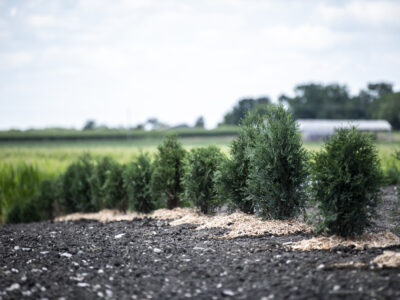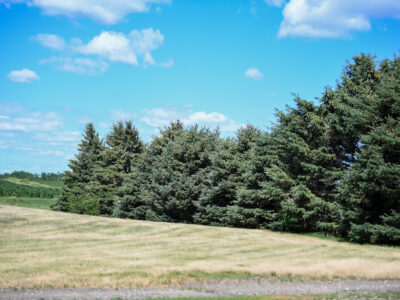Be Aware of Summer Tree Pests
05-15-2018 in Green Farmstead Partner
By Megyn Walston, CSIF Communications Intern
Pests travel quickly between trees, shrubs, grasses and other host crops making it important to identify the pests promptly. Early treatment and understanding how the pest spreads is essential in preventing these pests from causing further damage.
The Emerald Ash Borer (EAB) is a small, metallic green beetle with a flattened back and purple abdominal segments beneath its wing covers. Trees impacted may experience canopy dieback in the top one-third of the tree which may progress until the entire tree is bare. Other symptoms may include: epicormic shoots or sprouts growing from roots and trunks with leaves larger than normal, bark splitting, D-shaped exit holes, or increased woodpecker activity. EAB spreads by transportation of firewood or other wood materials (Michigan State University Dept. of Entomology). Arbor Jet recommends treating EAB before dieback symptoms exceed 40%. Insecticides are available but it is suggested to be proactive and consider spraying trees when EAB is found in the area.
The Zimmerman Pine Moth is a midsized moth with gray and red-brown wings marked with zig-zag lines. Larvae are generally dirty white to light gray, up to one inch long and burrow into pine trees and other conifers to feed on the sap produced by the tree. Caterpillars are deep in the trunk by late June through July and the wounds may look gummy. Other common symptoms are wilting and browning of new foliage or branch ends wilting and turning downward (Tree Geek). Blue Ribbon Lawn and Landscaping suggests applying insecticide the last week of April and the first week of August. Saturate the trunk as much as possible while also spraying the foliage. Timing of control is particularly important for the life cycle of this moth.
Japanese Beetles eat on fruits, flowers, and leaves to the point of skeletonizing. Larvae are white c-shaped grubs that feed on plant roots. Adults emerge mid-June through July and are 3/8 inches long and ¼ inch wide. The head and thorax are shiny metallic green with coppery red wing covers. The most distinguishing feature is the row of 5 tufts of white hairs on each side of the abdomen. Japanese beetles can be tough to control because of their wide range of hosts and extended time-frame of emergence. Iowa State University Extension recommends spot spraying infested foliage and multiple insecticide applications may be necessary to maintain control. Spraying the adult stage is not an effective strategy for preventing white grubs.
No pest is the same, therefore there is no “one size fits all” for pest control. Do your research or consult a specialist to determine the best control practices. For more information about common pests and control, check out these helpful sites:
http://www.iowatreepests.com/index.html
https://www.extension.iastate.edu/
Recommended News

Growing the Ag Environment
Ryan and Lana Reed of Wapello County spent an almost-spring-like March day tending to the windbreak near two of their hog barns. Planted in 2010, the fast-growing austree hybrid willow...
Read More
Ames Landscaper Joins Green Farmstead Partner Program
West Des Moines, Iowa – April 4, 2023 — Landscape Legends of Ames has been designated a participating landscape professional in the Coalition to Support Iowa’s Farmers’ (CSIF) Green Farmstead...
Read More
Derecho Brings Opportunity for Story County Family
Brian Sampson of Story County is an optimist. “I like to be around people who think most things are possible,” says Sampson. When the derecho rolled through his farm last...
Read More